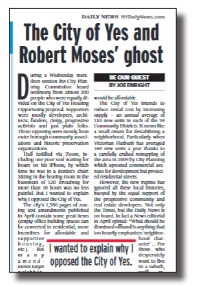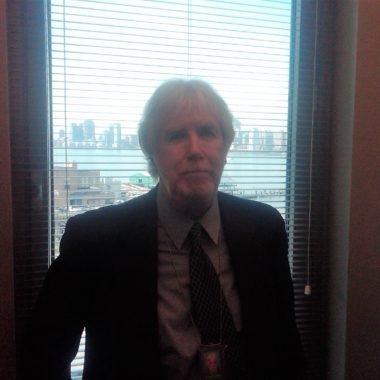There’s a proverb about good intensions often leading to doom. Take the Adams Administration’s “City of Yes Housing Opportunity.” I’ll bet the branding consultants got well paid on this one. To support City of Yes is to be for “Housing” and “Opportunity.” To be against it is to be for homelessness and despair. And as for “City”? Why, join the bandwagon, mate, it’s not just Gowanus or Red Hook – it’s the whole damned place this time!
Simply put, the proposal intends to build an estimated maximum of 100,000 apartments over the next 15 years, “sprinkled” across the City’s 59 Community Districts, in the hope that about 160 new apartments in each District each year will make it easier to find a place to live. The theory is, “If you build new apartments, the supply will decrease demand, existing apartments will become more affordable and we’ll all live happily ever after.” There’s two ways to look at this:
1) the Planners were doing too much weed while cooking this up during Pandemic down time and they really believe that 160 unaffordable apartments (condos) distributed in districts containing an average of 125,000 residents will really reduce rents; or
2) they didn’t add some zeros after the number so as not to lead to demands for Environmental Impact Studies. That would take way too long and show the potential harm these zoning changes could have on each District’s infrastructure, density, transportation and quality of life over time. Nope, better to estimate 160.
The impact here at the southern end of Victorian Flatbush would be heavy. For instance, 29 stately houses built in 1905 face our major gathering place, the Flatbush Mall along Glenwood Road, and 20 of them could be demolished and replaced with 3-5 story multiple-unit dwellings containing up to 10 apartments (or condos) – non affordable, of course – exploding the density. Homeowners can add backyard dwellings 25 feet high. Two family houses can become three family, garages can become apartments. Buildings can be expanded into McMansions. All without any review. Half of Victorian Flatbush consists of landmarked districts that are virtually indistinguishable from the other half. The Landmarks Commission would have to approve any of the changes above and as presently composed, that seems unlikely. The key phrase in the previous sentence was “as presently composed.” Our anxiety is shared by the majority of neighborhoods in the City where detached homes predominate.
This locomotive left the station in late April, blew past the 59 Community Boards (30 of whom advised “we’d rather you not do a lot of this stuff”), then suffered through a 14 hour City Planning Commission hearing in early July (the Commission is presently deciding what minor tweaks to make so they can claim “we heard your complaints, people!”) And in September, the 1,300 page proposal will be plopped on the desks of 51 City Council Members for action within 50 days. It’s what’s called a “zoning text amendment” to the existing Zoning Resolution which itself is over 4,000 pages long. So City of Yes requires a 1,300 page rewrite for 160 new apartments in Flatbush every year? Sounds like, “We had to destroy existing zoning – and this village – in order to save it.”
And make no mistake, it is being referred to by Yay–and–Nay sayers alike as nothing less than a sweeping attempt to rewrite the residential zoning regulations across the entire City.
Developers wet dream
It represents the fever dream of a generation of academics steeped in land use history whose ideas have trickled down from the ivory towers, feeding the imaginations and grievances of a coalition of planners and progressive activists. Their mantra is rendered thusly: the zoning resolution passed in 1961 and subsequently modified here and there is the work of Beelzebub, designed to protect segregated enclaves of 1 & 2 family detached homes by preventing apartment houses full of “those people” on residential blocks.
And all the talk emanating from those privileged enclaves about “protecting the character of a neighborhood” – once the mantra of urban planners –is now regarded as thinly disguised racist fol-de-rol. No, these bucolic neighborhoods must be peppered with brutally ugly, bulky buildings to atone for our sins.
The entire development-realtor industry in New York City heard these cries and suddenly they were preaching from the same hymnal to every aggrieved person unable to find good affordable apartments without doubling/tripling up and looking for someone to blame. Why, it couldn’t possibly be developers or politicians. Who’s left? Must be the homeowners.
When developers are told the apartments they can build in new desirable locations can all be market rate (i.e., unaffordable to most), watch out for the stampeding speculators in these low density districts. And no need to deal with the (UGH!) traditional City oversight process? Nirvana! Simply buy a plot of land sitting on a 5,000 square foot lot that’s within a half-mile of a subway station (maybe buy two lots and conjoin them), demolish anything on it and send your expeditor down to DOB bearing the new building plan (along with a gift perhaps), and voila.
Of course, there are many other goodies for developers: apartment buildings in mid and high density zoning districts can be taller, no parking spots are required for any new buildings anywhere, incentives exist for sprinkling affordable apartments into the high density districts, and conversion of empty commercial space to residential is highly blessed.
After a New York Minute, the developer-builder-realtor community temporarily interrupted writing their donor checks to the entire political class of this great city and poured coal on the PR fire. The editorial boards of the Times and News agreed: “Frankly, Planning Dudes, you had us at City of Yes! Such a catchy phrase.” In fact, the Daily News ran two editorials (in April and July), literally advising outer borough homeowners: “If you don’t like it, move to the suburbs!”
Naturally, as one of those outer borough homeowners being told to get out of Dodge, I had to disagree and, promising to buy a lot of rounds, I got an OpEd published in the News a day after their second screed (thereby demonstrating their fair play?) So there I was, tugging at heartstrings about the transformation of Victorian Flatbush, an historically beautiful neighborhood, into a hodgepodge of cheap developer stew over the next decade if this thing passes. But here’s what I had to leave out.
I bought my house in a 1-2 family enclave in the 1980s but by segregation standards it must have been an outlier, inasmuch as the local public school had kids from all over the world. The neighborhood was just recovering from hard times, having been redlined by banks, racked with arson and plenty of other crime. My wife and I needed two mortgages and money from relatives who pretended not to remember me. This was when Brooklyn wasn’t cool.
The house leaked, drainpipes didn’t drain, and the heating system sucked. I would chase off trespassers and car thieves while the local Precinct was busy responding to homicides and robberies, I was also dragged into a PD-sponsored “citizen patrol” with walkie-talkies and a flashing light plugged into my dashboard cigarette lighter, gathering F-Bombs from all the cars behind us as we cruised slowly down our blocks at 15 MPH. Eden it was not.
Gradually, things changed. Suddenly everybody in the world wanted a piece of the Big Apple. Many just wanted one of the thousands of empty condos in midtown to hide their assets, others wanted to make it here after hearing Sinatra belt out “New York, New York,” or while watching Seinfeld. Demand for apartments increased in the wake of downtown Brooklyn redevelopment, and active and passive harassment to force renters out and make units market rate.
There weren’t many places for growing families to live. Only 15% of the City’s housing stock consists of 1 & 2 family homes and as demand increased, prices rose. And as old-timers sold their homes, they were bought by the usual mix of NYC emigrees and young families, all with one desire in common: a back yard, bedrooms and a nearby public school. And you know what else they wanted? Diversity. A place where we could all live peacefully together, with respect for separate customs.
Not only does my neighborhood reflect the diversity of Brooklyn, it also reflects the escalation of housing prices. After allowing for inflation, our house is now worth three times what we paid for it and that has nothing to do with my fixing the drainpipes. Flatbush homes were affordable until Flatbush became more desirable. Developers will build where the demand is greatest and where they can make a profit. But the cost of plots in desirable areas only rises as more development occurs, with the result that rental/condo prices rise too. Williamsburg and Bushwick were more affordable until they became more desirable. Duh.
In the end, we’ll have more condos that few can afford in cheap non-quality buildings and neighbors will be upset with neighbors and absentee owners over-building “as of right.” All of it untested, proposed without any local study, no pilot program, no discretionary review, no trial period.
The City Council stands in the way. They will try to reprise their “City of Yes Economic Opportunity” episode from May when they were able to prevent haberdashers, massage parlors or what have you from operating out of street corner homes, and tweaked some other crazy stuff. They’ll try to tweak “Housing Opportunity” too, leaving in enough goodies so they don’t alienate their donors. Hopefully in this instance they’ll value their constituents more.










